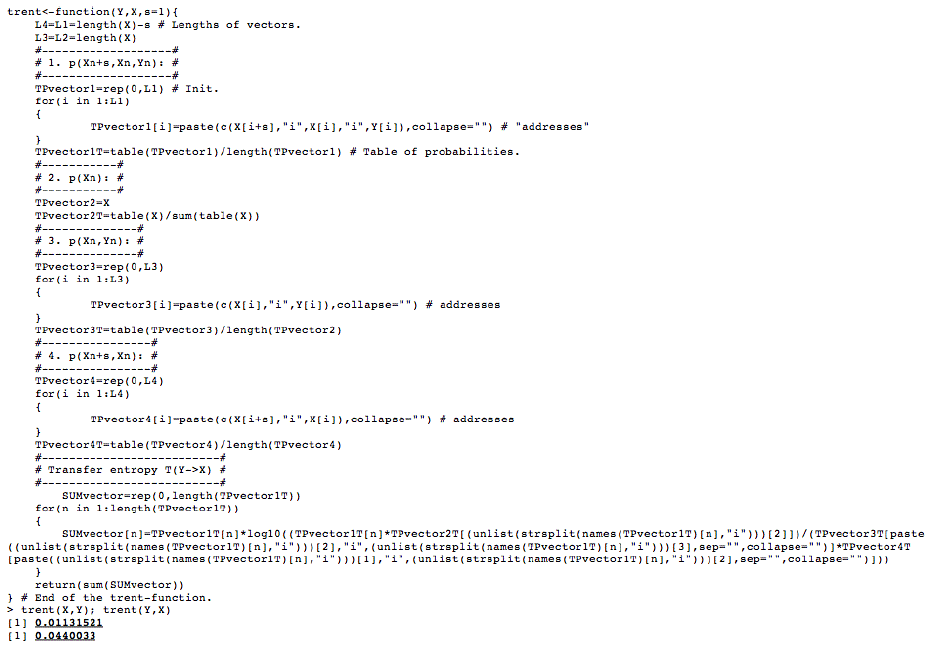the same as above from the same page http://users.utu.fi/attenka/trent.R
###############################
###############################
## FUNCTION TRANSFER ENTROPY ##
###############################
###############################
# 070527 (ver. 081126), Atte Tenkanen
# s, time shift
trent<-function(Y,X,s=1){
#---------------------------------#
# Transition probability vectors: #
#---------------------------------#
L4=L1=length(X)-s # Lengths of vector Xn+1.
L3=L2=length(X) # Lengths of vector Xn (and Yn).
#-------------------#
# 1. p(Xn+s,Xn,Yn): #
#-------------------#
TPvector1=rep(0,L1) # Init.
for(i in 1:L1)
{
TPvector1[i]=paste(c(X[i+s],"i",X[i],"i",Y[i]),collapse="") # "addresses"
}
TPvector1T=table(TPvector1)/length(TPvector1) # Table of probabilities.
#-----------#
# 2. p(Xn): #
#-----------#
TPvector2=X
TPvector2T=table(X)/sum(table(X))
#--------------#
# 3. p(Xn,Yn): #
#--------------#
TPvector3=rep(0,L3)
for(i in 1:L3)
{
TPvector3[i]=paste(c(X[i],"i",Y[i]),collapse="") # addresses
}
TPvector3T=table(TPvector3)/length(TPvector2)
#----------------#
# 4. p(Xn+s,Xn): #
#----------------#
TPvector4=rep(0,L4)
for(i in 1:L4)
{
TPvector4[i]=paste(c(X[i+s],"i",X[i]),collapse="") # addresses
}
TPvector4T=table(TPvector4)/length(TPvector4)
#--------------------------#
# Transfer entropy T(Y->X) #
#--------------------------#
SUMvector=rep(0,length(TPvector1T))
for(n in 1:length(TPvector1T))
{
SUMvector[n]=TPvector1T[n]*log10((TPvector1T[n]*TPvector2T[(unlist(strsplit(names(TPvector1T)[n],"i")))[2]])/(TPvector3T[paste((unlist(strsplit(names(TPvector1T)[n],"i")))[2],"i",(unlist(strsplit(names(TPvector1T)[n],"i")))[3],sep="",collapse="")]*TPvector4T[paste((unlist(strsplit(names(TPvector1T)[n],"i")))[1],"i",(unlist(strsplit(names(TPvector1T)[n],"i")))[2],sep="",collapse="")]))
}
return(sum(SUMvector))
} # End of the trent-function.

